Last Updated on December 13, 2023
For some, the joy of travel goes beyond merely seeing the sights. Many of us also enjoy traveling to learn…and I learned much at the Lewis and Clark Interpretive Center in Great Falls
Estimated reading time: 6 minutes
The major museums of the world – such as the Smithsonian, the Louvre, British Museum and scores of others worldwide – have long been superb learning centers and magnets for travelers.
They are fascinating places to experience a variety of cultures and learn more about the world about us. For many of us they are high on our lists of places to visit when we’re traveling to any city.
But there are also other small places of learning that we know little about, which we sometimes stumble upon in our wanderings. That’s precisely what happened while we were driving through Montana not long ago.
Lewis and Clark Interpretive Center, Great Falls, Montana
Like most of us I never knew much about the American explorers Lewis and Clark except for what I retained from an hour or two of in my high school history class or, perhaps, from a PBS special.
While driving up to Montana’s Glacier National Park my husband and I overnighted in Great Falls, Montana, about three hours south of the park.
It was there we learned more about the Lewis and Clark Interpretive Center in Great Falls and decided to visit it before heading northward. It turned out to be one of the most interesting parts of our trip.
Learning the Why of It All at the Great Falls Center
What made it so enjoyable was that it is both highly interactive and educational, not just in the obvious sense of where they traveled, but also the depth of detail about the experience and people involved.
I was also amazed to learn the reason the 1804 expedition took place at all.
I knew from school that President Jefferson had acquired the Louisiana Territory without really knowing what he was buying. But now I learned why the expedition was especially important for Jefferson: the price he paid was about three times the amount authorized by Congress and he needed to justify the additional expense.
He chose Lewis and Clark to lead the expedition because he had a personal relationship with them. They also had military experience and shared a personal interest in agriculture, nature and medicine.
Enter A Nervous Napoleon
Another exhibit provided additional detail about the New World at the time and the vying factions for the Territory.
One was Spain, which at the time had conquered what today is all of California, Mexico, Florida and the Dominican Republic. England, though, was vying for the Northern Territories, which at that time also included present-day Oregon and Washington.
The French, of course, laid claim to the Louisiana Territory while the young United States wanted the entire continent for expansion.
Napoleon, I learned, was getting nervous about the cost of the new war with Britain and perceived the sale of Louisiana as an easy way to generate funds. It also made the looming fight with Britain, over the remaining unclaimed territory in the Northwest of the New World, a problem for the U.S. instead of France.
Overcoming Communication Issues
The further on I moved through the Interpretive Center, the more infatuated I became with the fascinating facts about obstacles to be overcome, and not just the geographic ones.
Lewis and Clark were negotiating with various tribes for everything from horses to food, and it was interesting is to learn how the Indians were receptive and liked to barter.
In fact, they managed to establish very good relationships with the tribes they encountered along the route; it was the people who followed them that caused the subsequent difficulties and fighting with the Indians.
One obstacle they continually faced was the need to communicate in a language they did not know. Their solution was to use three or four different people speaking different languages until they “reached” the language of the tribe. A key in the communication chain was the Indian woman Sacagawea.
Learning the Story of Sacagawea at the Center
The Lewis and Clark Interpretive Center in Great Falls is home to fascinating exhibits about the expedition. One of the most interesting is about Sacagawea.
Sacagawea acted as a translator for Lewis and Clark for most of their journey to the Pacific and back, and helped them to overcome great obstacles.
In 1800, when she was approximately 12 years old, she was kidnapped from her tribe by an enemy war party. She was subsequently sold as a slave to Toussaint Charbonneau, a French-Canadian fur trader, who took her and another Indian woman as his wives.
Sacagawea and her fur-trader husband were hired by the expedition as translators, as well as for her ability to help to Lewis and Clark through the Rocky Mountains where she had grown up, and to barter with Indian tribes for much-needed horses.
The Lewis and Clark Interpretive Center is a fascinating place well worth a visit if you’re in Great Falls, or a stop on a road trip if you’re anywhere nearby. Most likely you’ll be fascinated by it.
You may also enjoy: Fort Benton, MT and the Missouri Breaks / Why Yellowstone Is Perfect for a Family Vacation / Texas Road Trip: the Chisholm Trail
If You Go:
There are several Lewis and Clark Interpretive Centers in the western U.S. as well as other sites and centers of varying interest. These are the most notable:
Great Falls, Montana
4201 Giant Springs Road
Great Falls, MT 59405
Tel: (406) 727-8733
Lewis and Clark Interpretive Center – Great Falls
Astoria, Oregon
Lewis and Clark National Historical Park
92343 Fort Clatsop Rd, Astoria, OR 97103
Tel: (503) 861-2471
Lewis and Clark Interpretive Center – Astoria
Ilwaco, Washington
Lewis and Clark Interpretive Center
Cape Disappointment State Park
244 Robert Gray Dr,
Ilwaco, WA 98624
Tel: (360) 642-3029
Washburn, North Dakota
2576 8th Street SW
Washburn, ND 58577
Tel: (701) 462-8535
Lewis and Clark Interpretive Center – Washburn

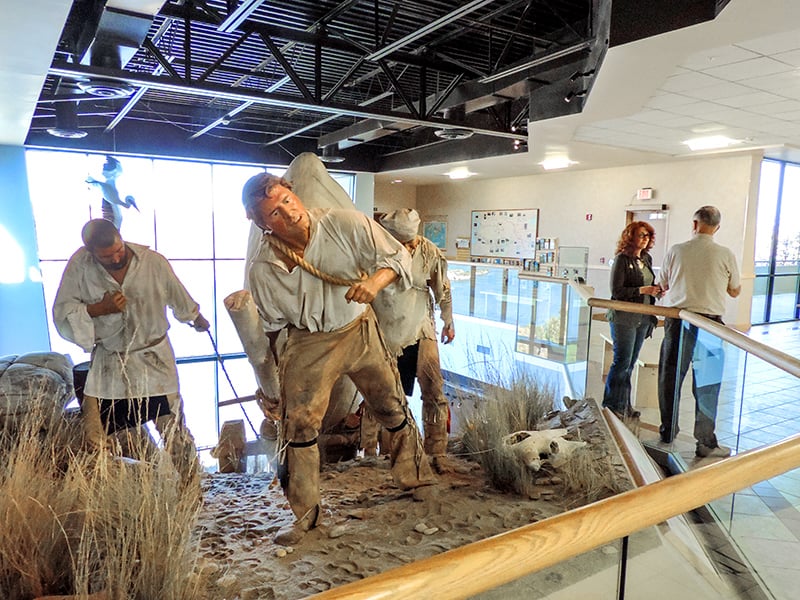
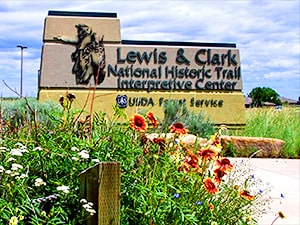
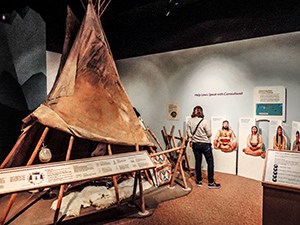
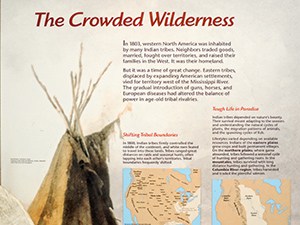
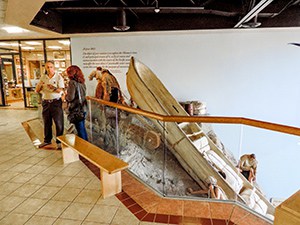
Marjorie — Loved this article. Wini
I was there August 2020, but due to COVD( even in Montana) the center was restricted to the upper floor. Everyone was wearing masks, contrary to what was said about federal facilities. Because of the inability to see the whole center, the usual $5 fee was waived. The center is situated along the Missouri. A similar gem just up the highway in Fort Benton is another BLM interpretive center regarding the Upper Missouri Breaks area. It has on display among other things Chief Joseph’s surrender Winchester…The town has really cool Grand Union Hotel and a visitor center across from a riverside walk area that goes over to the old original fort…That is maybe more interesting that the interpretive center. It had docent volunteers, that when I was there, essentially gave us a personal tour. The volunteers there were enthusiastically knowledgeable…in fact there was a rotating collection of bronzes by Bob Scriver of Browning whose family allows a rotation of the various pieces so it’s never really the same…I found local restaurants friendly with delicious fare as well as local atmosphere in old restored buildings an unexpected delight…There is even the old bridge you can walk across and look down on the river. As wide as the Mighty Mo is, it can be extremely shallow…The bridge was the original highway crossing and would rotate to allow river boats to pass and dock near the Grand Union Hotel. Fort Benton was the upper most reach of the Missouri due to the obvious Great Falls. It was the main step off point for the stage to parts elsewhere like Helena…now a great not so secret gem of the Lewis and Clark experience. Great Falls with the CM Russell museum, Lewis and Clark Interpretive Center as well as the museum at Malmstrom AFB where one can get details about the Minuteman missile network, it being the base that maintains and services the system….Rob, the curator is great!
Thanks for these insights Bill.